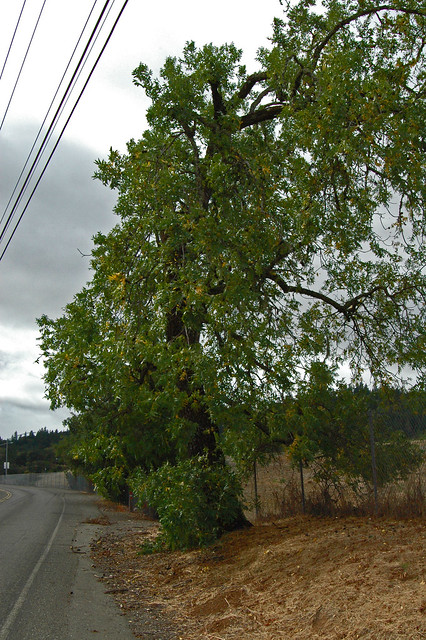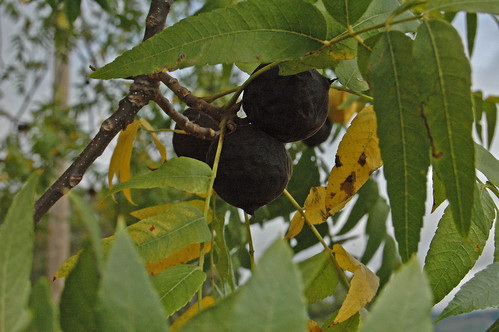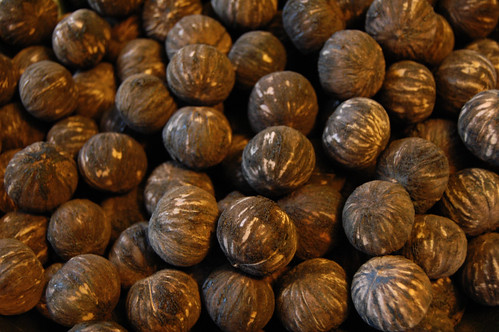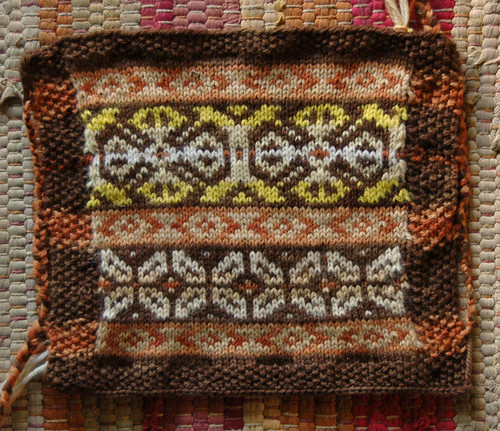Walnut Dye? That's Nuts!
...
One of the many nice things about doing the BORP ride (more on that, anon) is spending hours in California's beautiful wine country. The event take place at harvest time, and there's so much to see (and smell). This year, less than a mile into the the ride, I noticed a couple of California Black Walnut trees on the strip of land between the freeway and the service road on which we were riding. The next day, after having stopped to buy some champagne from the winery that hosts the BORP event, we paused to collect black walnuts.
Walnuts have fleshy hulls, which grow around their hard shells, and these hulls have long been used to dye textiles. In fact, the knitting project I had brought to work on during our car ride was partially dyed with walnut hulls.
I got pretty lucky in terms of walnut harvesting. The tree had dropped most of its crop, and all I had to do was fill my bags.
The processing was significantly more work. The hulls had to be scraped off of the walnuts' shells. I used a wicked-looking curved linoleum knife. (That's the kind that's used for trimming flooring, not the kind used for carving relief prints.) I wore heavy rubber gloves, because I had read that the walnut hulls are powerful skin dyes. Getting sick with bronchitis immediately after the BORP ride actually worked in my favor. I left the nuts sitting for two weeks, and during that time, the hulls had a chance to dry out, which made it easier to separate them from the shells.
I spent hours hulling those nuts. I suppose I could have just dumped the entire nut into the boiling dye-pot, but if I'd done that I would have ruined the nut-meats. In the end, I harvested a couple of pounds of walnut hulls, and a huge bowl of walnuts in their shells. That's more dye than I can possibly imagine using any time soon.
California Black Walnuts are tough nuts to crack, much more challenging than the English -- or more accurately Persian -- Walnuts we're used to eating. I think the best method for extracting the nut-meats will involve some kind of screw mechanism, inside of a sealed container. The shells are so much thicker than what we're used to cracking, and tend to fly all over the place.
I'm still chugging along on my Kauni cardigan, but once that's done my next big project will be a cardigan dyed entirely with locally found natural dyestuffs. The dark brown in this sample was all dyed with walnut hulls. I'm pretty excited to get started on this project.
How about you, blog readers? Are you foraging anything these days?
One of the many nice things about doing the BORP ride (more on that, anon) is spending hours in California's beautiful wine country. The event take place at harvest time, and there's so much to see (and smell). This year, less than a mile into the the ride, I noticed a couple of California Black Walnut trees on the strip of land between the freeway and the service road on which we were riding. The next day, after having stopped to buy some champagne from the winery that hosts the BORP event, we paused to collect black walnuts.
Walnuts have fleshy hulls, which grow around their hard shells, and these hulls have long been used to dye textiles. In fact, the knitting project I had brought to work on during our car ride was partially dyed with walnut hulls.
I got pretty lucky in terms of walnut harvesting. The tree had dropped most of its crop, and all I had to do was fill my bags.
The processing was significantly more work. The hulls had to be scraped off of the walnuts' shells. I used a wicked-looking curved linoleum knife. (That's the kind that's used for trimming flooring, not the kind used for carving relief prints.) I wore heavy rubber gloves, because I had read that the walnut hulls are powerful skin dyes. Getting sick with bronchitis immediately after the BORP ride actually worked in my favor. I left the nuts sitting for two weeks, and during that time, the hulls had a chance to dry out, which made it easier to separate them from the shells.
I spent hours hulling those nuts. I suppose I could have just dumped the entire nut into the boiling dye-pot, but if I'd done that I would have ruined the nut-meats. In the end, I harvested a couple of pounds of walnut hulls, and a huge bowl of walnuts in their shells. That's more dye than I can possibly imagine using any time soon.
California Black Walnuts are tough nuts to crack, much more challenging than the English -- or more accurately Persian -- Walnuts we're used to eating. I think the best method for extracting the nut-meats will involve some kind of screw mechanism, inside of a sealed container. The shells are so much thicker than what we're used to cracking, and tend to fly all over the place.
I'm still chugging along on my Kauni cardigan, but once that's done my next big project will be a cardigan dyed entirely with locally found natural dyestuffs. The dark brown in this sample was all dyed with walnut hulls. I'm pretty excited to get started on this project.
How about you, blog readers? Are you foraging anything these days?






Comments
Larvalady-ZZ
I haven't done much in the way of natural dyeing (coffee and tea, mostly); when I was in the SCA I kept intending to get there eventually. I did eventually get to spinning, so there's hope, right?
I keep thinking I should try beet juice. It's just SO pink.